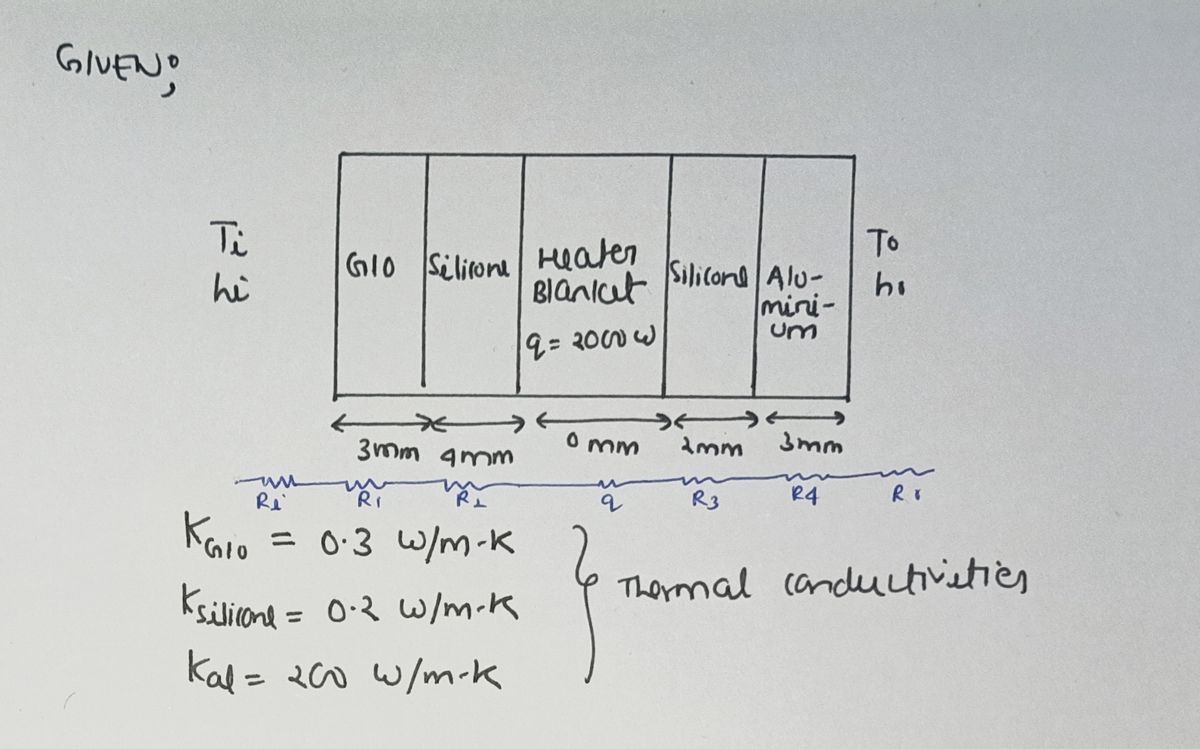Problem 5: When making a heater, one side is often against a surface which you don't want to be heated. One way to prevent heating that side is to insulate that side of the heater such that most of the heat power is directed to the side you do want heated. An example of that is below. What is the heat flux to the left side of the heater blanket? Neglect the thickness of the blanket (Omm). Treat it as infinitely thin. T01 = 25°C W h1 = 12 m²K T2 = 60°C W = 30 m²K Heater Blanket G10 Silicone Silicone Aluminum h2 q = 2000W 3mm 4mm Omm 2mm 3mm
Problem 5: When making a heater, one side is often against a surface which you don't want to be heated. One way to prevent heating that side is to insulate that side of the heater such that most of the heat power is directed to the side you do want heated. An example of that is below. What is the heat flux to the left side of the heater blanket? Neglect the thickness of the blanket (Omm). Treat it as infinitely thin. T01 = 25°C W h1 = 12 m²K T2 = 60°C W = 30 m²K Heater Blanket G10 Silicone Silicone Aluminum h2 q = 2000W 3mm 4mm Omm 2mm 3mm
Introduction to Chemical Engineering Thermodynamics
8th Edition
ISBN:9781259696527
Author:J.M. Smith Termodinamica en ingenieria quimica, Hendrick C Van Ness, Michael Abbott, Mark Swihart
Publisher:J.M. Smith Termodinamica en ingenieria quimica, Hendrick C Van Ness, Michael Abbott, Mark Swihart
Chapter1: Introduction
Section: Chapter Questions
Problem 1.1P
Related questions
Question
Thermal Conductivity of G10 fiberglass is 0.3 silcone is 0.2 aluminum is 200

Transcribed Image Text:Problem 5: When making a heater, one side is often against a surface which you don't want to be
heated. One way to prevent heating that side is to insulate that side of the heater such that most of the
heat power is directed to the side you do want heated. An example of that is below. What is the heat
flux to the left side of the heater blanket? Neglect the thickness of the blanket (0mm). Treat it as
infinitely thin.
To2 = 60°C
W
T01 = 25°C
W
h, = 12
m²K
Heater Blanket
Aluminum h2 = 30
m²K
G10
Silicone
Silicone
q = 2000W
3mm
4mm
Omm
2mm
3mm
Expert Solution
Step 1

Step by step
Solved in 2 steps with 2 images

Knowledge Booster
Learn more about
Need a deep-dive on the concept behind this application? Look no further. Learn more about this topic, chemical-engineering and related others by exploring similar questions and additional content below.Recommended textbooks for you

Introduction to Chemical Engineering Thermodynami…
Chemical Engineering
ISBN:
9781259696527
Author:
J.M. Smith Termodinamica en ingenieria quimica, Hendrick C Van Ness, Michael Abbott, Mark Swihart
Publisher:
McGraw-Hill Education

Elementary Principles of Chemical Processes, Bind…
Chemical Engineering
ISBN:
9781118431221
Author:
Richard M. Felder, Ronald W. Rousseau, Lisa G. Bullard
Publisher:
WILEY

Elements of Chemical Reaction Engineering (5th Ed…
Chemical Engineering
ISBN:
9780133887518
Author:
H. Scott Fogler
Publisher:
Prentice Hall

Introduction to Chemical Engineering Thermodynami…
Chemical Engineering
ISBN:
9781259696527
Author:
J.M. Smith Termodinamica en ingenieria quimica, Hendrick C Van Ness, Michael Abbott, Mark Swihart
Publisher:
McGraw-Hill Education

Elementary Principles of Chemical Processes, Bind…
Chemical Engineering
ISBN:
9781118431221
Author:
Richard M. Felder, Ronald W. Rousseau, Lisa G. Bullard
Publisher:
WILEY

Elements of Chemical Reaction Engineering (5th Ed…
Chemical Engineering
ISBN:
9780133887518
Author:
H. Scott Fogler
Publisher:
Prentice Hall


Industrial Plastics: Theory and Applications
Chemical Engineering
ISBN:
9781285061238
Author:
Lokensgard, Erik
Publisher:
Delmar Cengage Learning

Unit Operations of Chemical Engineering
Chemical Engineering
ISBN:
9780072848236
Author:
Warren McCabe, Julian C. Smith, Peter Harriott
Publisher:
McGraw-Hill Companies, The